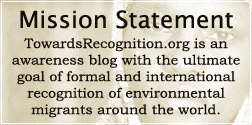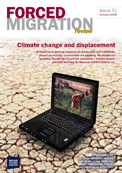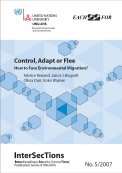The UN Climate Change Conference in Copenhagen convened last Friday. Unfortunately, due to lack of free (and working) internet access during my visit, I wasn’t able to update the blog as often as I wanted. However, here is a roundup of the second week migration and displacement events that I attended at COP15 as well as some thoughts about the issue as a whole in relation to the entire Conference.
The draft agreement which contains the entry referring to climate change and human mobility, has not been adopted at this COP. This would be just one of the many reasons people say the talks failed. According to this document made available on the UNFCCC website, the text will continue to be worked on by Parties and further narrowed down in future climate talks. In regards to the actual paragraph itself, according to this article “many have sought to alter the passage and Australia has attempted to water it down and has requested more research.”
The “CARE and Migration” panel talk was cancelled. This was most likely due to the fact that many of the civil society observers that were supposed to be speaking at various events were not able to gain entry into the Conference venue due to logistical issues, so many ended up cancelling their trip to Copenhagen altogether.
The event “Climate adaptation continuum, migration and displacement – Copenhagen and beyond” at the Conference last Wednesday was well attended and progressive with the issue. It had a very distinguished panel and included William Lacy Swing, Director General of IOM, and António Guterres, the UN High Commissioner for Refugees. Among the issues discussed at the side event, the notion of increased illegal human trafficking and smuggling was brought up by the panel in regards to a possible continuation of lack of formal and legal recognition of climate migration. The future challenges of incorporating migration into adaptation strategies also continued to be discussed. Check out this page for a more comprehensive summary of this event.
Here is the webcast from the press conference, “UNU, UNHCR and IOM: migration/displacement and climate change” which took place last Wednesday. It seemed very rushed but many important questions from the press were addressed by the panel.
During the side events, it seemed that for every one question from the participants, there were more questions raised. Delegates from Bangladesh asked many questions and pleaded their case at every migration event I attended. They are on the front lines of climate change and for them, this was an opportunity for the people at the top to hear their voices.
Overall, the issues of migration and displacement from the effects of climate change were not addressed properly at COP15, as mitigation measures were still the predominant focus. Although climate migration and displacement is currently happening around the world, it is still fairly new on the international agenda and much remains to be done. However it is very clear that concrete action is needed right now in the most vulnerable and affected countries, regardless of formal recognition in a legally binding treaty.
As a side note, I also had the chance to see the documentary film “Climate Refugees” by Michael P. Nash. Although I strongly disagree with the message that climate migration is a national security threat for developed countries in which this film graphically portrays, I still think there are some good interviews and comments made as well as ways forward to help mitigate the effects of climate change.
There are a few publications that were released during or just before COP15 that you should be aware of. The first is “Climate Changed: People Displaced” by the Norwegian Refugee Council (NRC). This is an excellent thematic report which aims to raise awareness of displacement as one of the humanitarian impacts of climate change. The lead author of this report, Vikram Kolmannskog, also published the working paper “Climate change, disaster, displacement and migration: initial evidence from Africa” for UNHCR’s “New Issues in Refugee Research” series. The report presents evidence from Burundi and Somalia, which are among the most vulnerable countries in the world.
Another one is by IOM and is entitled “Migration, Environment and Climate Change: Assessing the Evidence”. The book focuses on seven key areas of research relating to the topic of migration, the environment and climate change, covering issues such as data challenges, research methods, sudden environmental and slow-onset events, and policy responses.
Lastly, here is a press release by IOM entitled “Greater efforts needed to tackle environmental migration beyond Copenhagen”, which was released on International Migrants Day on December 18, which also happened to be the last day of the Conference.
Here are a few more pics from inside Bella Center and around Copenhagen, as well as some from the side events I attended in the second week. A special shout-out to all of the readers of the blog that I had the honor to meet in person at the Conference!
We cannot display this gallery


